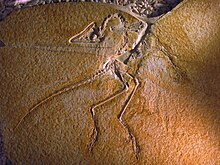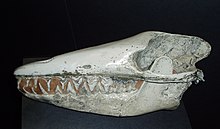This page is dedicated to an analysis of the variety of transitional fossils currently known.
Prominent Examples of Transitional Fossils in the Animal Kingdom
Archaeopteryx
Archaeopteryx
| The original Archaeopteryx fossil |
Archaeopteryx is one of the most famous transitional fossils
and gives evidence for the evolution of birds from theropod dinosaurs.
Archaeopteryx is a genus of theropod dinosaur closely
related to the birds. Since the late 19th century, it has been accepted by
palaeontologists, and celebrated in later reference works, as being the oldest
known bird.
It lived in what is now southern Germany in the Late
Jurassic period around 150 million years ago, when Europe was an archipelago in
a shallow warm tropical sea, much closer to the equator than it is now.
Similar in shape to a European Magpie, with the largest individuals possibly attaining the size of a raven, Archaeopteryx could grow to about 0.5 metres (1.6 ft) in length. Despite its small size, broad wings, and inferred ability to fly or glide, Archaeopteryx has more in common with other small Mesozoic dinosaurs than it does with modern birds. In particular, it shares the following features with the deinonychosaurs (dromaeosaurs and troodontids): jaws with sharp teeth, three fingers with claws, a long bony tail, hyperextensible second toes ("killing claw"), feathers (which suggest homeothermy), and various skeletal features. These features make Archaeopteryx a clear candidate for a transitional fossil between dinosaurs and birds, making it important in the study both of dinosaurs and of the origin of birds.
 |
| Anatomical illustration comparing the "fan-tail" of the modern bird with the "frond-tail" of Archaeopteryx |
Similar in shape to a European Magpie, with the largest individuals possibly attaining the size of a raven, Archaeopteryx could grow to about 0.5 metres (1.6 ft) in length. Despite its small size, broad wings, and inferred ability to fly or glide, Archaeopteryx has more in common with other small Mesozoic dinosaurs than it does with modern birds. In particular, it shares the following features with the deinonychosaurs (dromaeosaurs and troodontids): jaws with sharp teeth, three fingers with claws, a long bony tail, hyperextensible second toes ("killing claw"), feathers (which suggest homeothermy), and various skeletal features. These features make Archaeopteryx a clear candidate for a transitional fossil between dinosaurs and birds, making it important in the study both of dinosaurs and of the origin of birds.
Below is a timeline of Archaeopteryx discoveries and their locations:

Here is a compilation of the variety of Archaeopteryx fossils that have been discovered across the globe as mentioned in the above table:
 |
| Munich Specimen |
 |
| London Specimen |
 |
| The feather specimen |
 |
| Maxburg Specimen |
 |
| Haarlem Specimen |
 |
| Daiting Specimen |
 |
| Solnhofen Specimen |
 |
| Thermopolis Specimen |
 |
| Eichstatt Specimen |
 |
| "chicken wing" Specimen |
Pakicetids
The ancestors of whales
Their fossils were first discovered in North Pakistan in 1979, at a river not far from the shores of former Tethys Sea. Pakicetids could hear under water, using enhanced bone conduction, rather than depending on tympanic membrane like most land mammals. This arrangement does not give directional hearing under water.
No pakicetids have been
found in marine deposits, and they were apparently terrestrial or freshwater
animals. Their long limbs and small hands and feet also indicate they were poor
swimmers. Their bones are heavy and compact and were probably used as ballast;
they clearly indicate pakicetids were not fast runners notwithstanding their
otherwise cursorial morphology. Most likely, pakicetids lived in or near bodies
of freshwater and their diet can have included both land animals and aquatic
organisms.
Here are some examples of Pakicetid fossils.
 |
| Pakicetus attoki |
 |
| Pakicetid skull found in Pakistan |
Ambulocetus natans, which lived about 49 million years ago, was discovered in Pakistan in 1994. It was probably amphibious, and resembled the crocodile in appearance.

In the Eocene, ambulocetids inhabited the bays and estuaries of the Tethys Ocean in northern Pakistan. The fossils of ambulocetids are always found in near-shore shallow marine deposits associated with abundant marine plant fossils and littoral molluscs. Although they are found only in marine deposits, their oxygen isotope values indicate that they consumed water with a range of degrees of salinity, some specimens showing no evidence of sea water consumption and others none of fresh water consumption at the time when their teeth were fossilized.
It is clear that ambulocetids tolerated a wide range of salt concentrations. Their diet probably included land animals that approached water for drinking, or freshwater aquatic organisms that lived in the river. Hence, ambulocetids represent the transition phase of cetacean ancestors between freshwater and marine habitat.
Fish
 |
| Discovery Site |
Tiktaalik lived approximately 375 million years ago.
Paleontologists suggest that it is representative of the transition between
non-tetrapod vertebrates such as Panderichthys, known from fossils 380 million
years old, and early tetrapods such as Acanthostega and Ichthyostega, known
from fossils about 365 million years old.
 Its mixture of primitive fish and
derived tetrapod characteristics led one of its discoverers, Neil Shubin, to
characterize Tiktaalik as a "fishapod". Unlike many previous,
more fish-like transitional fossils, the "fins" of Tiktaalik have
basic wrist bones and simple rays reminiscent of fingers. They may have been
weight bearing. Like all modern tetrapods, it had rib bones, a mobile neck with
a separate pectoral girdle, and lungs, though it had the gills, scales, and
fins of a fish.
Its mixture of primitive fish and
derived tetrapod characteristics led one of its discoverers, Neil Shubin, to
characterize Tiktaalik as a "fishapod". Unlike many previous,
more fish-like transitional fossils, the "fins" of Tiktaalik have
basic wrist bones and simple rays reminiscent of fingers. They may have been
weight bearing. Like all modern tetrapods, it had rib bones, a mobile neck with
a separate pectoral girdle, and lungs, though it had the gills, scales, and
fins of a fish.  |
| Devonian Era Fish Species |
Pleuronectiformes (flatfish) are an order of ray-finned fish. The most obvious characteristic of the modern flatfish is their asymmetry, with both eyes on the same side of the head in the adult fish.
Other distinguishing features of the order are the presence of protrusible eyes, another adaptation to living on the seabed (benthos), and the extension of the dorsal fin onto the head.
 |
| Modern-Day American Sole Flatfish |
Paleontologists concluded that "the change happened gradually, in a way consistent with evolution via natural selection—not suddenly, as researchers once had little choice but to believe."
Plants
Runcaria
| Modern-day Dahlia (descendant of Runcaria) |
No comments:
Post a Comment